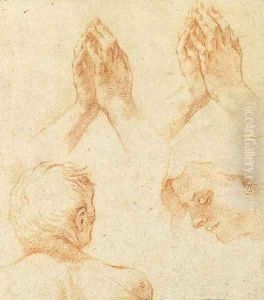Brtolomeo Cesi Paintings
Bartolomeo Cesi was an Italian painter and draughtsman, belonging to the Baroque period, one of the notable artists of the Bolognese School. Born in Bologna in 1556, Cesi was deeply influenced by the cultural and artistic ferment of his time, which was marked by the Counter-Reformation's impact on art. His work reflects the period's shift towards more emotional, dynamic, and naturalistic themes, diverging from the rigid and formal styles of the earlier Renaissance.
Cesi's training began under the guidance of Giovanni Francesco Bezzo, also known as Il Nosadella, and he was significantly influenced by the works of Pellegrino Tibaldi and Prospero Fontana, leading figures in Bolognese art. However, it was his encounter with the Carracci family, particularly Ludovico Carracci, that profoundly shaped his style and approach to painting. The Carracci advocated for a return to the study of nature and the emulation of the best aspects of High Renaissance masters, which resonated with Cesi's artistic inclinations.
Throughout his career, Bartolomeo Cesi worked on numerous commissions for local churches and noble families, decorating chapels and palaces with his frescoes and altarpieces. His works are characterized by their serene beauty, clarity of form, and delicate coloration, embodying the ideals of the Baroque movement in Bologna. Among his most notable works are the frescoes in the Benedictine monastery of San Michele in Bosco and the chapel decorations in the Bolognese church of San Giacomo Maggiore, which exemplify his skill in creating harmonious and spiritually uplifting compositions.
Cesi also played a significant role in the Accademia degli Incamminati, founded by the Carracci brothers, which was instrumental in the development of the Bolognese School. Through his involvement, he contributed to the training of the next generation of artists, including Guido Reni and Domenichino, who would become key figures in the spread of Baroque art across Italy and beyond.
Bartolomeo Cesi's legacy is marked by his contributions to the evolution of Italian art at the turn of the 17th century, bridging the gap between the Renaissance and Baroque periods. He passed away in Bologna in 1629, leaving behind a body of work that continues to be celebrated for its elegance, devoutness, and technical mastery.
